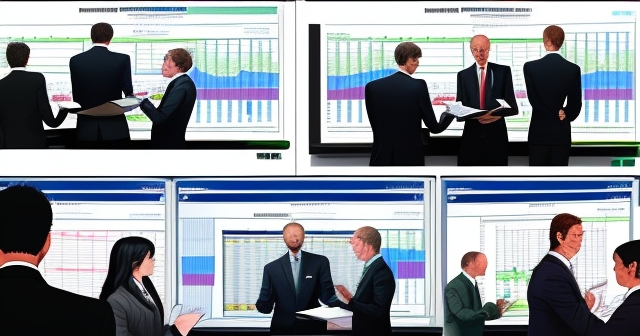Understanding Principal Trading: The Broker-Dealer’s Own Account
Have you ever placed an order to buy or sell stocks, bonds, or other securities? You click a button or tell your broker, and moments later, the transaction is complete. It seems straightforward, right? But have you ever stopped to think about what truly happens behind the scenes? How does your broker actually find someone willing to take the other side of your trade? The answer often boils down to two fundamental ways brokerage firms handle your orders: acting as an agent or acting as a principal. In this comprehensive guide, we’re going to delve deep into the world of principal trading, exploring what it is, how it differs from agency trading, its benefits, risks, and the crucial regulatory landscape that governs it. Understanding this distinction is vital, especially as you move beyond basic investing and seek to grasp the mechanics that underpin market efficiency and execution.

The Foundation: Broker vs. Dealer Roles
Before we define principal trading, we need to clarify the dual capacity that many financial firms operate under. A single entity, often called a broker-dealer, can play two distinct roles in the market:
- Broker: When a firm acts as a broker, it is simply an intermediary. Think of them as a matchmaker. Their job is to connect a buyer with a seller. They do not use their own money or hold the securities themselves during the execution of the trade. Their profit comes from charging a commission for facilitating the transaction. They act on your behalf, the client, to find a counterparty in the broader market.
- Dealer: When a firm acts as a dealer, they become a principal party in the transaction. They trade for their own account. This means they are either buying securities from you to add to their own firm’s inventory or selling securities to you from their existing inventory. In this role, they are not just connecting parties; they are *one* of the parties in the trade. Their profit typically comes from the difference between the price they buy at and the price they sell at (the bid-ask spread) or from the appreciation in the value of the securities they hold.
Most large financial firms are registered as broker-dealers and can operate in either capacity depending on the nature of the transaction and regulatory requirements. Recognizing which role your firm is playing in a specific transaction is key to understanding your execution and potential conflicts of interest.
| Role | Description |
|---|---|
| Broker | Acts as an intermediary and charges commission for transactions. |
| Dealer | Trades for their own account, taking on risk by holding inventory. |
What Exactly is a Principal Trade?
At its core, a principal trade occurs when a brokerage firm completes a customer’s order by buying the security from the customer into its own inventory or selling the security to the customer from its own inventory. The brokerage is acting as a dealer in this scenario. Imagine you want to sell 100 shares of a stock. Instead of finding another investor on an exchange who wants to buy those exact shares at that moment (which would be an agency trade), your broker might step in and buy those 100 shares directly from you into their firm’s own account. Conversely, if you want to buy shares, the broker might sell them to you from the shares they already hold.
This mechanism is fundamentally different from the broker acting as an agent. In a principal trade, the firm takes on the other side of your transaction. They are not just facilitating a handshake between you and a stranger in the market; they are shaking your hand themselves, buying from you or selling to you directly. This requires the firm to have an inventory of securities they are willing to trade.
Think of a principal trade like selling an item to a pawn shop or a used car dealership. You walk in with your item (the security you want to sell), and the dealer (the brokerage) assesses it and buys it from you directly, adding it to their stock. They aren’t finding another buyer for you; they *are* the buyer. Similarly, if you want to buy a specific used car, you go to the dealership and buy it directly from their lot (their inventory). The dealership isn’t connecting you with the previous owner; they *are* the seller.

Executing a principal order means the broker-dealer is committing its own capital and taking on the risk associated with holding the security. This is a crucial point that differentiates it from agency trading.
Agency Trading: The Counterpoint
To truly understand principal trading, it’s helpful to have a clear picture of its opposite: agency trading. When your broker acts as an agent, they are doing what most people intuitively imagine a stockbroker does. You tell them you want to buy shares, and they go out into the market – perhaps the secondary market on an exchange like the New York Stock Exchange or Nasdaq – and find someone who is willing to sell those shares at your desired price (or the prevailing market price). Once they find that seller, they facilitate the exchange between you, the buyer, and the other party, the seller. Your broker never takes ownership of the shares during this process, not even for a second.
The agent’s role is purely facilitative. They use their access to the market to execute your instructions. For this service, they charge you a commission or fee. The risks involved in price fluctuations while the order is pending execution are primarily borne by you, the client, or by the other party in the market, not the broker acting as agent.
Imagine our earlier analogy: In agency trading, the broker is like a real estate agent. You tell them you want to buy a house. They don’t sell you one of their own houses; they search the market, find a seller whose house matches your criteria, and help you and the seller complete the transaction. They earn a commission for their service.
Most trades executed for retail investors – everyday individuals buying and selling relatively small amounts of stocks, ETFs, or mutual funds – are handled on an agency basis. This is due to various factors including regulation, the scale of the trades, and the typical needs of retail clients.
For instance, if you’re interested in diversifying your portfolio and perhaps exploring instruments like forex or CFDs, the choice of platform and execution type becomes relevant. Many platforms designed for active trading facilitate agency execution for retail spot forex transactions, connecting buyers and sellers in a highly liquid market. If you’re considering starting forex trading or exploring more CFD products, then Moneta Markets is a platform worth considering. It is from Australia and offers over 1000 financial instruments, suitable for both beginners and professional traders.

Process Comparison: How Your Order Gets Filled
Let’s walk through simplified processes to highlight the difference:
- Agency Trade Process:
- You place an order to buy 100 shares of XYZ stock.
- Your brokerage receives the order as an agency order.
- The broker sends your order to an exchange or other market venue.
- The order interacts with orders from other buyers and sellers in the market.
- A counterparty (another investor) is found who is willing to sell 100 shares of XYZ at the current market price.
- The broker facilitates the exchange: money goes from you to the seller, and shares go from the seller to you.
- Your account is debited for the price of the shares plus a commission; the seller’s account is credited for the price minus any fees.
- Post-trade processing (clearing and settlement) is handled by entities like the DTCC (Depository Trust & Clearing Corporation) and its subsidiary, the NSCC (National Securities Clearing Corporation), ensuring the transfer of securities and funds. The NSCC acts as a central counterparty, guaranteeing delivery and payment, which significantly reduces risk in the market.
In this process, your broker never owned the shares you bought; they just helped you find the person who did.
- Principal Trade Process:
- You place an order to buy 100 shares of XYZ stock.
- Your brokerage receives the order. Based on market conditions, its own inventory, or internal policies, it decides to execute the order as a principal trade.
- The brokerage sells you 100 shares of XYZ directly from its own inventory.
- Your account is debited for the price of the shares. There is typically no separate commission listed, as the profit is embedded in the price (usually reflecting the bid-ask spread and potentially a markup).
- The shares are transferred from the brokerage’s account to yours.
- Again, post-trade processes involving clearing and settlement facilities like the DTCC are required to finalize the legal transfer of ownership and funds, although the counterparty here is the broker-dealer itself.
In this process, your broker acted as the seller, using shares it already held.
The key difference lies in who is on the other side of the transaction: another market participant in agency trading, or the broker-dealer itself in principal trading.

Show Me the Money: Profit Mechanisms for Brokerages
The way a brokerage firm makes money differs significantly depending on whether it’s acting as an agent or a principal. This difference in profit mechanism is fundamental to understanding the firm’s motivations and potential conflicts of interest.
- Agency Trading Profit: As we discussed, the primary source of profit for an agent is the commission charged to the client for executing the trade. This commission can be a fixed fee per trade, a per-share fee, or a percentage of the transaction value. The broker’s goal is simply to execute your trade as efficiently as possible to earn their fee. They don’t care if the price goes up or down after the trade; their profit is made on the transaction itself.
- Principal Trading Profit: When acting as a principal, the brokerage firm makes money in a different way. Their profit comes from the difference between the price at which they buy a security and the price at which they sell it. This often means profiting from the bid-ask spread. For example, a dealer might be willing to buy a stock at $10.00 (the bid price) and sell it at $10.05 (the ask price). If they buy from one client at $10.00 and immediately sell to another client at $10.05, they pocket the $0.05 difference (minus any transaction costs). This is called “making a market.” Additionally, if they buy a security into their inventory and its price increases, they can sell it later at a higher price, realizing a profit from price appreciation.
| Trading Type | Profit Mechanism |
|---|---|
| Agency Trading | Profit from commissions on executed trades. |
| Principal Trading | Profit from the bid-ask spread and price movements of securities. |
Because a principal trader profits from the spread or price movements, they have a vested interest in the price at which the transaction occurs. This inherent interest is where potential conflicts of interest can arise, a topic we will explore in more detail shortly.
Understanding these distinct profit models helps illuminate why firms choose one method over the other for different types of trades or clients. For highly liquid markets with frequent trading, capturing the spread through principal trading can be a very profitable activity. For less liquid securities or smaller orders, an agency model might be more appropriate or required by regulation.
The Double-Edged Sword: Risks in Principal Trading
While profitable and often necessary for market function, principal trading comes with significant risks for the brokerage firm acting as a dealer. These risks are precisely why they demand the potential for higher profits (via the spread or price appreciation) compared to the simple commission in agency trades.
- Holding Risk (Inventory Risk): When a dealer buys a security into its inventory, it immediately takes on the risk that the price of that security could fall before they are able to sell it. Market volatility can quickly erode the value of their holdings, potentially leading to substantial losses. The larger and less liquid the inventory, the greater this risk.
- Liquidity Risk: A dealer holds inventory with the intention of selling it. If they cannot find buyers for the securities in their inventory in a timely manner or without significantly lowering the price, they face liquidity risk. This is particularly relevant for less actively traded securities.
- Market Manipulation Risk: While heavily regulated and illegal, the potential for a dealer to influence prices through their trading activities exists. By holding large positions, a dealer could theoretically attempt to move prices in a way that benefits their inventory, though regulatory oversight aims to prevent this.
- Conflict of Interest Risk: This is perhaps the most significant risk from the client’s perspective and a major focus of regulation. When a firm acts as a principal, its financial interest (selling from inventory at a high price or buying for inventory at a low price) might be different from your interest (buying at the lowest possible price or selling at the highest possible price). The firm might be tempted to execute your trade at a price that is favorable to its inventory position rather than the absolute best price available in the broader market.
| Risk Type | Description |
|---|---|
| Holding Risk | Risk of price decline for securities held in inventory. |
| Liquidity Risk | Risk of not finding buyers for securities in inventory. |
| Market Manipulation Risk | Potential to influence prices through trading activities. |
These risks require principal trading firms to have sophisticated risk management systems and sufficient capital. The conflict of interest risk, however, is managed primarily through stringent regulatory requirements focused on disclosure and client consent.
The Watchdogs: Regulation and Compliance
Given the inherent conflict of interest potential and the significant role principal trading plays in the market, it is a heavily regulated activity, particularly in jurisdictions like the United States under the oversight of bodies such as the Securities and Exchange Commission (SEC) and the Financial Industry Regulatory Authority (FINRA). These regulations are designed to protect investors and ensure market integrity.
- Notification Requirements: Broker-dealers are typically required to identify and flag trades executed in a principal capacity to the relevant exchange or regulatory body. This allows regulators to monitor principal trading activity for potential abuses.
- Disclosure Requirements: This is paramount. Firms engaging in principal trades with clients must provide clear and conspicuous disclosure that they are acting as a principal in the transaction. This informs the client that the firm is trading from its own account. The nature and level of disclosure can vary depending on the type of client (retail vs. institutional) and the specific securities involved. The SEC has emphasized that disclosures must be adequate and clear, not buried in fine print.
- Client Consent: For certain types of clients, particularly advisory clients under the Investment Advisers Act of 1940, specific consent rules apply. An investment adviser cannot knowingly engage in a principal transaction with a client (buying from or selling to the client for the adviser’s own account) without disclosing the capacity in which the adviser is acting and obtaining the client’s consent *before* the completion of the transaction. This is a critical safeguard to ensure clients are aware of the potential conflict and agree to proceed.
- Fair Pricing and Best Execution: While executing a principal trade, firms still have obligations regarding fair pricing. They cannot simply name an arbitrary price; the price should be reasonably related to the prevailing market price. Although the “best execution” standard is often more strictly associated with agency trades (where the broker must strive to find the best price available in the market), firms executing principal trades must still demonstrate that the transaction is not disadvantageous to the client. In situations involving less liquid assets or specific contexts like private funds, independent third-party valuation may be required or recommended to help ensure fairness.
These regulatory frameworks are constantly reviewed and enforced to balance the benefits principal trading provides (like liquidity) against the risks it introduces. Non-compliance can result in significant penalties for firms.
Why Principal Trading Matters: Liquidity and Market Function
If principal trading has potential conflicts and risks, why is it allowed and even encouraged in many market contexts? The answer lies in its crucial role in providing liquidity. Liquidity refers to the ease with which an asset can be bought or sold in the market without significantly impacting its price. A liquid market is one where there are always ready buyers and sellers.
Dealer firms, by standing ready to buy securities into their inventory or sell from their inventory, act as shock absorbers in the market. They bridge temporary gaps between supply and demand. Imagine a situation where a large institution wants to sell a significant block of shares. Finding a single buyer, or even a group of buyers through agency means, might take time and could depress the price as the large sell order hits the market. A dealer, acting as a principal, might be willing to buy that entire block into its inventory immediately, providing instant liquidity to the seller and preventing a potential price collapse. The dealer then takes on the task of selling those shares over time, managing the risk themselves.

This ability to absorb large orders and provide immediate counterparties is particularly important in markets for less liquid securities, bonds (Fixed Income), or in certain private markets contexts. Without dealers willing to commit capital as principals, many transactions would be much slower, more difficult, and potentially happen at significantly worse prices for the client. Principal trading, therefore, contributes significantly to the smooth functioning and efficiency of the secondary market.
Principal Trading in Practice: Institutional Focus and Specific Cases
While the principles apply broadly, principal trading is far more common and relevant in the world of institutional investors than for everyday retail investors. Institutions, such as pension funds, mutual funds, and hedge funds, often trade large blocks of securities that are difficult to execute purely on an agency basis in the open market without causing price disruption. Broker-dealers frequently step in as principals to facilitate these large transactions.
Beyond traditional stocks and bonds, principal trading concepts are also seen in specific areas:
- Fixed Income Markets: A significant portion of bond trading occurs “over-the-counter” (OTC) rather than on centralized exchanges. Dealers play a critical role here, quoting prices at which they are willing to buy and sell bonds from their inventory, effectively making a market.
- Private Equity and Real Estate “Warehousing”: In private markets, like Private Equity or Real Estate funds, the concept of “warehousing” involves the fund sponsor or adviser buying assets with their own capital initially (acting as a principal) with the intention of selling them to the fund later. This allows the sponsor to acquire assets quickly when opportunities arise, before the fund has officially closed or drawn down capital from its limited partners. This is a form of principal transaction between the adviser/sponsor and the fund client. These situations trigger significant regulatory scrutiny regarding conflicts of interest, disclosure, consent, and the fairness of the price at which the assets are eventually sold to the fund, often necessitating independent valuation.
For most retail investors, while your brokerage firm is a broker-dealer, the vast majority of your trades will be executed on an agency basis. This is partly due to regulatory protections specific to retail clients and the logistical efficiency of aggregating small retail orders for execution on exchanges.
When you receive a trade confirmation from your brokerage, it should indicate whether the trade was executed on a principal or agency basis. Paying attention to these details can help you understand exactly how your order was handled.
Navigating Principal Trades as an Investor: Disclosure and Consent
As an investor, especially one with significant assets or potentially involved with investment advisers managing your portfolio, understanding the rules around principal trades is not just academic; it’s crucial for protecting your interests. The core principles to be aware of revolve around disclosure and consent.
Your brokerage firm or investment adviser has a responsibility to clearly inform you when they are proposing to act as a principal in a transaction with you. This disclosure should not be vague or hidden. It should explicitly state that they are selling you a security from their own account or buying a security from you for their own account. It should also explain the potential implications of this, including the potential conflict of interest.
For advisory relationships governed by the Investment Advisers Act of 1940, your adviser must obtain your specific consent *before* executing such a transaction. This isn’t a blanket consent you give when you open an account; it’s transaction-specific. This gives you the opportunity to review the details, understand the potential conflict, and decide if you are comfortable proceeding.
Why is this so important? Consider the potential conflict: If your adviser’s firm has a large position in a security that is performing poorly, they might be incentivized to sell that security to their advisory clients (acting as principal) rather than selling it into the open market at a potential loss or difficulty. Without clear disclosure and your informed consent, you could unknowingly buy a security that the firm is eager to offload, potentially not because it’s the best investment for *you*, but because it serves the firm’s inventory management needs. This is precisely the type of situation that regulators aim to prevent through strict rules.

In situations involving private funds or less liquid assets, the fairness of the transaction price is also paramount. If an adviser sells a warehoused asset to a fund, the price must be fair to the fund’s investors (the clients). This is where independent valuation plays a critical role, providing an objective assessment of the asset’s worth to ensure the principal transaction is conducted at arm’s length and is not detrimental to the client.
Being an informed investor means understanding not just *what* you are buying or selling, but *how* the transaction is being executed and the role your financial partner is playing. Don’t hesitate to ask your broker or adviser whether a trade is being proposed on a principal or agency basis and to explain the implications.
When choosing a platform or broker, especially if you plan to engage in various markets like stocks, options, futures, forex, or CFDs, understanding their execution practices is part of your due diligence. Some platforms are primarily agency-based for retail clients, while others might utilize principal execution for certain asset classes or order types. Understanding these nuances can help you choose a partner that aligns with your trading strategy and risk tolerance.
If you are exploring international markets, including forex trading, the regulatory environment and execution methods can vary. Finding a platform with strong regulatory backing is crucial. If you are looking for a foreign exchange broker with regulatory protection and global trading capabilities, Moneta Markets holds multi-country regulatory certifications such as FSCA, ASIC, and FSA, and offers comprehensive support including segregated client funds, free VPS, and 24/7 Chinese customer service, making it a preferred choice for many traders.
Conclusion: Principal vs. Agency – Knowing the Difference
We’ve covered significant ground today, exploring the difference between principal and agency trading – two fundamental ways your investment orders can be executed. We learned that in agency trading, your broker acts as a matchmaker, connecting you with a counterparty in the market and earning a commission. In contrast, in principal trading, your broker acts as a dealer, using their own inventory or account to complete your trade and profiting from the bid-ask spread or price movements, while taking on the risk of holding the securities.
Principal trading plays a vital role in providing market liquidity and facilitating the execution of large orders, particularly for institutional investors and in specific markets like Fixed Income or private assets involving warehousing. However, it also introduces inherent risks, most notably the potential for a conflict of interest between the firm’s financial interests and your own.
This is why strict regulation, spearheaded by bodies like the SEC, requires clear disclosure when firms act as principals and, in many cases, necessitates obtaining explicit client consent before executing such trades, particularly for advisory clients under the Investment Advisers Act of 1940. Ensuring fair pricing, sometimes verified through independent valuation, is also a key component of investor protection in these transactions.
For most retail investors, the majority of trades are handled on an agency basis. However, understanding the concept of principal trading provides valuable insight into the mechanics of financial markets, the potential motivations of financial firms, and the regulatory safeguards in place to protect investors. Being an informed participant, knowing whether your order is executed as principal or agency, and understanding the implications of each, empowers you to navigate the complexities of trading and investing with greater confidence. The financial world, like any complex system, has many layers beneath the surface, and peering into mechanisms like principal trading helps build a more complete picture.
what is a principal tradeFAQ
Q:What is principal trading?
A:Principal trading occurs when a brokerage firm buys or sells securities directly to and from its own inventory to complete a customer’s order.
Q:What are the risks involved in principal trading?
A:Principal trading carries risks such as holding risk, liquidity risk, market manipulation risk, and conflicts of interest with clients.
Q:What regulations govern principal trading?
A:Principal trading is regulated by organizations like the SEC and FINRA, which impose disclosure and consent requirements to protect investors.
